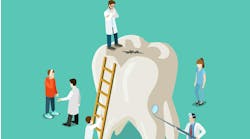By Roger P. Levin, DDS
"If your actions inspire others to dream more, learn more, do more, and become more, you are a leader." - John Quincy Adams
A common misconception about leadership holds that leaders spend their days giving orders and passing judgment on the performance of their subordinates.
To be effective practice leaders, dentists must move beyond this limited - and limiting - view. The reason many of them fall short as leaders is simply that they try to command rather than inspire. Even though he served as his nation's Commander in Chief, President John Quincy Adams understood that his real power grew out of his ability to inspire others. Dentists can follow his example and develop exceptional inspirational skills by following these seven steps:
1. Create, share, and promote a practice vision.
The most important tool a practice leader can have is a written vision statement that describes what the practice will be like in three years. Both the dentist and team need to have a clear picture of where the practice is going because this vision will inspire and shape their actions. The vision tells them what goals must be met, and the goals can be translated into a set of specific, measurable targets that will mark the office's progress toward fulfilling its vision.
As the practice owner, only the doctor can create the vision based on his or her passion for dentistry and desire to succeed by caring for others. The dentist must also take responsibility for ensuring that all team members understand and are working toward the vision. This involves explaining it thoroughly to the team and then keeping it top of mind by reading it aloud at the beginning of team meetings.
2. Empower staff members to do more ... and do it well.
It may seem counterintuitive, but the first step toward improving an underperforming team is to give them more responsibilities rather than more orders. By enabling them to feel that they are part of something greater than themselves - that they are making a significant contribution to the practice's success - the leader inspires them to excel. The delegation of virtually all administrative tasks to subordinates brings out the full potential of the staff. This shift not only inspires the team but also frees the doctor to spend more time - the target is 98% - providing direct patient care. The positive impact of this, in terms of potential practice production and professional satisfaction, is incalculable.
One caveat: The practice leader must make sure that all systems used by team members are updated for maximum efficiency and that all necessary training is provided. Otherwise, team members will feel frustrated and disappointed rather than inspired and empowered.
3. Build motivation into your interactions with team members.
Showing enthusiasm and other forms of staff "cheerleading" may come naturally to some dentists, but any personal style can be adapted to motivate the team. The practice leader must simply make an effort to motivate - encouraging, gently correcting, complimenting, thanking, reminding, empathizing, etc. By identifying and taking advantage of opportunities to make motivational comments, the dentist can inspire the team in many ways, every day.
4. Set high performance standards.
Mediocrity inspires no one. By settling for nothing short of excellence, the dentist encourages the team to work toward the highest standards of quality and the highest levels of personal and practice success.
In addition to responsibilities, accountability should also be assigned to appropriate staff members. As part of the practice's growth strategy, the dentist should establish a set of measurable performance targets - e.g., keeping 98% of patients scheduled at all times, closing 90% of all cases presented, receiving referrals from 40% to 60% of all patients every year, and more. When assigned to team members and used in meetings to measure actual performance, these targets set the bar high for everyone. When the practice falls short in one area, rather than finding blame, the practice leader and team can brainstorm ways to improve systems to achieve better results.
5. Keep an open mind.
Team members will be inspired if they see their leader replacing obsolete thinking with new ideas, learning better ways to run the practice as a business, and paying serious attention to team members' comments and suggestions. A "my way or the highway" attitude does not signify strength. It tells staff members they are not being paid to think. A leader inspires by listening, learning, adapting, and distributing credit where it belongs.
6. Handle decision-making wisely.
Aside from clinical issues, very few of the daily decisions in a dental practice merit the attention of the practice leader. Routine decision-making should be delegated to staff members along with performance responsibilities and accountability. They may sometimes make poor decisions but will soon rise to the occasion and do better.
The critical decisions that remain the responsibility of the doctor are another matter. While open-minded flexibility on the part of the practice leader will inspire the team, indecisiveness will not. It plants doubt and frustration. Freed from the burden of making numerous minor decisions every day, the dentist can concentrate on the major issues, weighing risks, considering all the "what-ifs," and then making a firm, clear-cut commitment. Whatever may be going on beneath the surface, the practice leader must present an image of assertiveness and confidence to team members. This demeanor will be highly inspirational.
7. Set a good example.
This final step of inspiring the team is also the easiest. The dentist must simply be the kind of employee he or she wants team members to be. As the prime role model, the doctor can teach good behavior and inspire imitation of that behavior without saying a word about it. For example, if the practice vision calls for providing an extraordinary level of customer service, team members can learn what that means, and what is expected of them, by watching how the dentist interacts with patients and increases patient satisfaction.
The business demands of the new dental economy have obliged practice owners to begin thinking of themselves not only as clinicians but also as business leaders. Generally lacking the business education, experience, and mentoring that leaders in other fields receive, many dentists feel uncertain about their leadership skills. However, by focusing on these seven steps, they can inspire their practice teams to serve patients exceptionally well, take pride in their work, and fulfill the practice owner's vision of success.
To learn how to run a more efficient, profitable, and satisfying practice, attend one of Dr. Levin's all-new seminars in 2015. Pick a date and location that fits your schedule at www.levingroup.com/gpseminars. You can also connect with Levin Group on Facebook and Twitter (Levin_Group) to learn strategies and share ideas.





